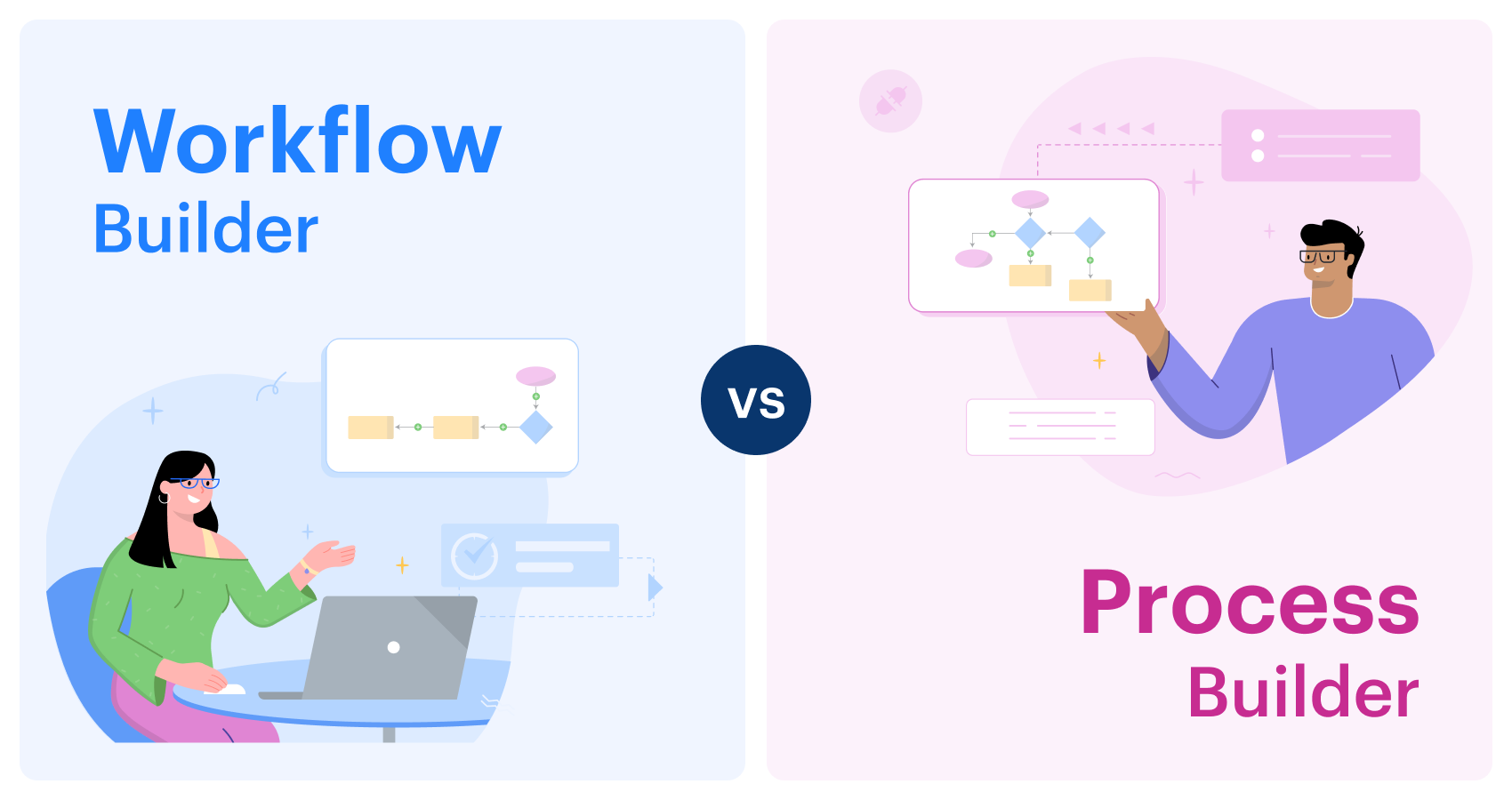Every business has a set of key standard processes vital to its survival that must be handled daily–whether it's assigning tasks, sending emails, or organizing meetings. To accomplish these processes, workflows are needed.
For a long time, organizations used manual, time-consuming processes. But today, most use tools such as process builders and workflow builders to autoconfigure processes and avoid manual, repetitive work. According to research firm Deloitte, 36% of organizations are using business process management software to automate workflows. This post examines the two enterprise solutions in detail.
What is Workflow Builder?
A workflow builder is a visual tool that helps businesses create highly efficient custom workflows that connect teams, organize work, and streamline projects. It automates a team’s routine processes and key workflows, seamlessly coordinating work. Workflow Builder enables professionally-designed, frictionless user experiences.
The software lets you build custom workflows using steps, transitions, and actions. It reduces manual workload and improves company productivity. Workflows can be as simple or as complex as you like.
A workflow builder’s visual development environment can help your organization solve real-time business problems by eliminating technological barriers. You can also connect it to other apps and services to get work done more efficiently.
What is Process Builder?
A process builder is a newer enterprise solution that allows users to control a business’s order of actions or evaluate a record’s criteria. Its point-and-click interface uses straightforward ‘If/Then’ logic to automate steps and actions easily. A user sees simple graphical representations as they build each process. 67% of organizations use business process automation solutions to enhance end-to-end visibility across different systems.
A process builder uses a trigger event, criteria, and action to automate business processes and reduce workflows. To meet varying automation needs, the software supports three process types, which then determine the triggers.
-
Event process: this begins when a user receives a platform event message.
-
Record change process: starts when a user creates or updates a record.
-
Invocable process: starts when something else, like another process, invokes it
Of the three processes, only the first two support scheduled actions.
Process builder vs Workflow - Key Differences
A workflow builder focuses on automating and creating a streamlined workflow that collaborates team and aligns tasks. A process builder uses a point-and-click interface to combine multiple workflows in a single process.

Process builder and workflow are both automation tools that activate when records are created or modified. However, the distinction lies in the fact that workflow represents a more traditional approach to automation, while process builder offers a user-friendly, visually appealing representation of the process during its creation.
Pros & Cons of Workflow Builder
|
Workflow Builder Advantages |
Workflow Builder Disadvantages |
|
It's a simple visual workflow editor |
You cannot delete records |
|
A single workflow environment for modeling and automation |
There’s no way to assign actions in a sequence |
|
Ideal for medium to large organizations that handle lots of data |
One workflow can only contain one set of entry criteria |
|
It's dependable and rarely crashes |
It can only update some fields on a parent record |
Pros & Cons of Process Builder
|
Process Builder Advantages |
Process Builder Advantages |
|
Combines multiple workflows in a single process |
You can’t change the order in which actions are specified and executed |
|
You can access apex code and replace simple tasks |
Deleting an object removes all the processes associated with that object |
|
Has a series of criteria (if-then statements), and you can assign multiple actions (to each) |
If an action fails, the entire process fails and the system displays an error |
|
Has a comprehensive list of features |
Cannot perform more complex actions |
|
Admins can establish the exact order of process operations |
Loading many records or running multiple queries simultaneously can make the software crash |
|
You can set notifications for both email and chatter group |
Cannot send an outbound message (communication with another system) |
Streamline Your Workflow Process With Kissflow
When to Use Workflow Builder & Process Builder?
A workflow builder helps users automate standard internal processes. It can be used to do the following:
- Create and assign tasks
- Send outbound messages to another system
- Update a field (not for related objects)
- Send email alerts
A process builder is ideal for updating current or child records. You can also create a project from a template.
With it, you can complete these actions:
- Send email alerts
- Post to Chatter
- Send custom notifications
- Create records and update related records
- Submit records for approval
- Launch a flow or a quick action
- Invoke a process from another process
- Call Apex methods
- View previous versions of Process Builder flows
- Call out to a Flow
- Perform an action in Quip
- Call out to another process builder
- Evaluate a new set of criteria if the first set hasn't been met
You can configure all these as immediate actions or schedule them to happen at a specific time.
Which is Better & Faster? - Workflow Builder or Process?
Both workflow and process builders are powerful tools that automate a business's tasks. They support actions such as drag and drop, letting users easily add or remove fields. Both tools are useful, but the most suitable one will depend on the tasks you’re trying to perform.
Compared to a workflow builder, a process builder offers more options on what actions to take and can quicken processes. Its additional features provide more automating abilities. However, it can be a hard tool to master. Also, its tendency to break down when given multiple commands is a major drawback.
With a workflow builder, you’ll have fewer issues with business processes, related code, and data updates because it's designed to handle bulk work. Also, unlike a process builder, it allows you to send outbound messages to another system.
Rather than choose one over the other, evaluate your requirements and then get the best tool for the job. If the task calls for workflow automation, use a workflow builder. If not, opt for a process builder.
Automate Your Processes with Kissflow
Inefficient workflows can decrease company revenue by up to 30%. One delayed signature or missed email could result in lost revenue. To ensure your workflows are truly optimized, automate. Eliminate mistakes from the equation and create reliable processes that cut costs where it matters most. Whether you decide to get a process builder or a workflow builder, Kissflow's workflow can help.
We’ll help you automate the tasks and processes that will have the most impact on your bottom line.
